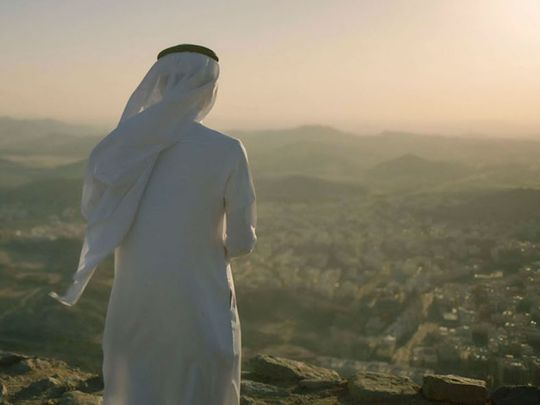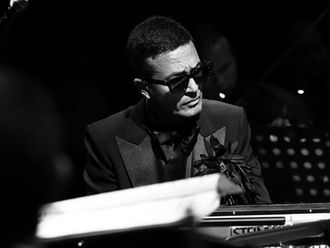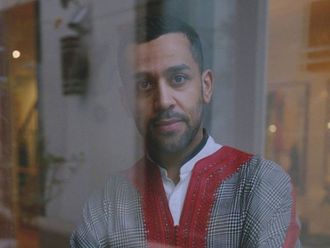
The story of Prophet Mohammad (PBUH) and the Hijrah when he was forced to leave Makkah 1,400 years ago is the subject of an acclaimed film shown at the Islamic Arts Biennale in Jeddah - The Kurator has spoken to the award-winning director Ovidio Salazar about the film.
The passageway from Makkah to Madinah is as arduous as it is beautiful, just like journey of Islam’s founder, the Prophet Mohammad (PBUH) when he was forced to flee Makkah to escape persecution for his religious teachings. Around 1,400 years ago, he and his followers left Makkah for Madinah in what has become known as Hijrah—the subject of a first-ever -cinematic account of the PBUH’s eight-day journey in 622 AD staged by the King Abdulaziz Center for World Culture (Ithra), directed by award-winning filmmaker Ovidio Salazar and titled In the Footsteps of the Prophet. “Through this film we are trying to show the beauty of Islam and its universal ideals of unity and tolerance that connect all people regardless of religion,” Salazar said.
Hijrah, which marked the spread of Islam and celebrates the ideas of tolerance and shared humanity, after the PBUH and his followers were accepted in Madinah, celebrated its anniversary last year. To mark the occasion and the new Islamic year, Ithra staged a cross-disciplinary project, ‘Hijrah: In the Footsteps of the Prophet’, launched in July 2022, comprising a major traveling exhibition, a documentary film, a scholarly publication and a virtual reality immersive experience.
Through enrapturing natural visages and in-depth narration of the Prophet’s journey, Salazar’s documentary follows the physical route of the Hijrah and Dr. Abdullah Alkadi, a leading authority on the PBUH as he uncovers groundbreaking topographical findings that provided the evidence-based foundations for the exhibition and documentary film.
“We are presenting new research, methodologies and findings based on extensive fieldwork that will redefine perspectives on this historic migration,” said Dr Abdullah Alkadi, scholar and -researcher. “The relevance of this story is just as strong today; it serves to demonstrate and remind us of the reasons why people choose to move from one place to another and asserts the right to practice your beliefs.” The documentary emphasises the beauty, heritage and arduous mental and physical journey the Prophet underwent during a moment when he questioned his faith. “The film is staged in a documentary setting to endow it with an artistic aesthetic,” Idries Trevathan, curator of Islamic Art at Ithra tells Arab News. Hijrah is a story that is -well-preserved in the cultural memory of generations of Muslims and it is being presented here in cinematic form for the first time since the 1976 film The Message, the last recent Islamic epic drama film directed and produced by Moustapha Akkad, chronicling the life and times of the PBUH through the perspective of his uncle Hamza ibn Abd al-Muttalib and adopted son Zayd ibn Harithah. “With Alkadi acting as guide, we retraced the path taken by the Prophet Muhammad on his monumental journey,” explains Salazar. “We intended to visualize details of a cultural memory essential to understanding Islam’s foundation story. I hope that In the Footsteps of the Prophet will help form a -deeper understanding and start a conversation inviting everyone to reflect on the meaning of migration itself.”
The film, says Salazar, is also groundbreaking because it gives PBUH visual form. “Since the 1976 film, no one has wanted to tackle subjects that render Prophet Mohammad in -visual form,” said Salazar. “It is complicated due to the complexity in Islam regarding the portrayal of the human form, particularly that of the Prophet.” Salazar and his team overcame such challenges by capturing the Prophet from the back or veiled—you never see his face. “There is no agenda with this film. We are expressing the universal message of the Hijrah that everyone can connect with and that will make it suitable for a wider audience,” says Trevathan. Adding that “we live in a very paced world with all the social media and technology that sometimes we think we need to go faster but in fact we need to slow down.” Ultimately, Ithra and the project’s organizers hope to encourage the viewer, regardless of religious faith, to appreciate the universal meaning of Hijrah.
“Both the film and the exhibition chart the Prophet’s eight-day journey, allowing the spectator to slow down and contemplate the landmarks and people he and his followers encountered on their journey,” says Kumail Almusal, Curator of International Exhibitions at Ithra.
The power of Ithra’s project lies in its multidisciplinary nature, involving as Almusal states, art, culture, Islam, archaeology and history and specialists from all of these fields to portray as accurately as possible the groundbreaking journey of the PBUH that continues to resonate in the cultural memory of all Muslims today. It is one, hope the organizers, that also touches the wider universal community regardless of religious faith.






